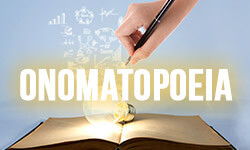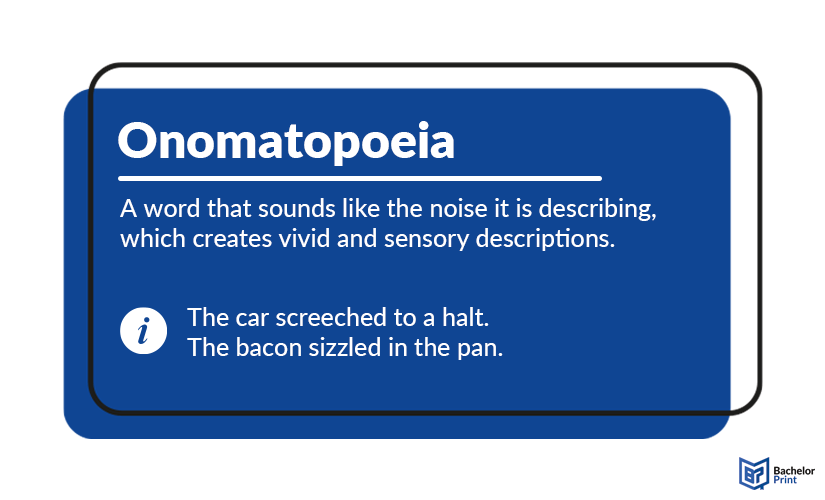
Onomatopoeia stands as a fascinating subject within the realm of linguistic studies. This stylistic device offers a bridge between the sounds of the real world and the abstract representations of language. In academic writing, the exploration of onomatopoeia enriches our understanding of linguistic creativity and unveils the intricate ways in which language can mirror the sensory experiences of life.
Definition: Onomatopoeia
Onomatopoeia is a figure of speech that refers to words that imitate the sounds associated with the objects or actions they describe. Essentially, it’s when a word sounds like what it represents. Common ones include “buzz” like the noise a bee makes and “hiss” which imitates the sound of a snake. These are often used in literature, poetry, and everyday language to create vivid and sensory descriptions. They allow us to convey sounds through words, adding richness and detail to our communication.
In linguistics, onomatopoeia refers to a word or sequence of sounds that imitates or suggests the source of a non-vocal sound, such as a noise produced by an object or natural phenomenon. It is a vague term that encompasses a wide range of linguistic expressions that mimic real-world sounds. They are frequently used to evoke sensory experiences and create vivid imagery in language, enriching communication by directly representing non-vocal sounds through vocal means.

Etymology
The term onomatopoeia has its roots in Greek. It comes from the combination of two Greek words:
- “onoma” — meaning “name” or “word”
- “poiein” — meaning “to make” or “to create”
So, when we put these together, it literally means “to make a word” or “to create a name.” Often, people misspell the word as “onomonopia.” This likely occurs due to the phonetic similarity between the correct spelling “onomatopoeia” and the mispronunciation “on-o-muh-NOH-pee-uh.” Since English spelling can be inconsistent and not always intuitive, people may unintentionally spell the word as “onomonopia” based on how they hear and pronounce the word.
Correct spelling
onomatopoeia
Incorrect spelling
onomonopia
Onomatopoeia in academic writing
In general, onomatopoeias are not commonly used in academic writing for several reasons.
Academic writing aims to be formal, objective, and precise. Onomatopoeias are often subjective and can be open to interpretation. They may not convey information with the clarity and precision required in academic essays. Typically, academic writing deals with complex ideas, theories, data analysis, and research findings.
Moreover, they are more commonly associated with descriptive or narrative writing, where sensory detail and vivid imagery are prioritized over factual information. They also may be perceived as too informal or colloquial for academic contexts, like in a research paper, where a more professional and authoritative tone is expected.
Finally, they can be ambiguous or culturally specific, leading to potential misunderstandings or confusion among readers. Academic writing strives for clarity and objectivity, and the use of them may hinder these goals.
However, there may be exceptions to this general rule, particularly in disciplines where descriptive language and sensory detail are integral to the research topic.
Use
Onomatopoeias are used in language to vividly depict a wide range of sounds associated with various aspects of life. Here’s how they are commonly used. We also included examples of onomatopoeia.
Onomatopoeias play a fascinating role in capturing the vibrant sounds of the animal kingdom. They are frequently used to represent the animal sounds. These linguistic devices provide a direct connection between language and natural sounds, allowing us to vividly describe and understand the unique sounds produced by animals. They imitate natural sounds that are shaped by the human language. This figure of speech enables us to replicate and appreciate the rich tapestry of animal sounds.
By mimicking these natural sounds, onomatopoeias help us communicate about animals more effectively, fostering a deeper connection to the natural world and its diverse inhabitants. The following examples are only applicable to the English language. Other languages use different sounds for the same animals.
In the realm of human sounds and actions, onomatopoeias capture the vast array of noises and movements that define our everyday experiences. Through language, we can add depth to our stories, poetry, and conversations, reflecting the human experience.
Besides animal sounds, onomatopoeias can also describe natural sounds or sounds that are produced by inanimate objects. The following are distinct sounds one stumbles upon in nature.
In the world of comics, onomatopoeias serve as dynamic tools for conveying action, intensity, and atmosphere. These sound effects, represented by onomatopoeic words, add a layer of immediacy and excitement to the visual storytelling experience. From the “BAM!” of a superhero’s punch to the “POW!” of an explosion, using them in comics brings the action to life on the page, enhancing the reader’s engagement and immersion in the narrative.
Types
The classification of onomatopoeias into three types provides a framework for understanding the different ways in which these words function within language. Here’s an explanation of each type.
Onomatopoeias that name sounds
These are words that directly imitate or represent the sounds they describe. They closely mimic the actual auditory experience and are often used to vividly portray noises.
Onomatopoeias that name things connected with sounds
These describe objects, actions, or phenomena that are closely associated with specific sounds. While they may not directly mimic the actual sound itself, they evoke the concept of the sound through their usage.
Onomatopoeias that mimic something else physical
These imitate or evoke a physical sensation or action that is associated with a sound, rather than directly representing the sound itself. They create a sense of movement, texture, or physicality in language.
The sound of the word “smooth” itself conveys a sense of fluidity and consistency. The prolonged “oo” creates a continuous sound followed by the soft “th” sound, creating a flowing auditory experience that mirrors the idea of smoothness in texture. Additionally, the word smoothly rolls off the tongue without any abrupt or jagged interruptions, further enhancing its mimetic quality.
The word “craggy” mimics the physical appearance and sensation of unevenness and roughness. The hard, guttural “cr” sound at the beginning of the word evokes the idea of hardness and solidity, reminiscent of the hard surfaces found in landscapes. The abrupt transition from the hard “cr” to the soft “aggy” mirrors the sharp contrast between the rough peaks and the softer valleys of craggy terrain.
- ✓ 3D live preview of your individual configuration
- ✓ Free express delivery for every single purchase
- ✓ Top-notch bindings with customised embossing

Other languages
Onomatopoeias are prevalent across various languages, each offering unique expressions that capture symbolic sounds and enrich communication. In Japanese, the symbolism in sounds is particularly prominent in their language, playing a crucial role in everyday speech and cultural expression.
In Arabic, this figure of speech plays a significant role in everyday speech, poetry, and literature, representing the significance of symbolism in sounds in their language.
In Hebrew, onomatopoeias are utilized to capture symbolic sounds and actions vividly, adding depth and sensory detail to communication. These expressive linguistic tools play a significant role in everyday speech, literature, and cultural expressions.
Effect in literature
Onomatopoeias play a significant role in literature by adding vividness, imagery, and sensory detail to writing. They allow authors to recreate sounds and experiences within the minds of readers, enhancing the immersive quality of the narrative. Here’s how they are used in literature, along with examples.
Creating atmosphere
Onomatopoeias are often used to set the mood or atmosphere of a scene by evoking specific sounds associated with the setting.
Enhancing action and movement
Onomatopoeias are used to describe actions or movements with greater vividness and immediacy. They bring scenes to life by replicating the sounds of motion.
Conveying emotion and mood
Onomatopoeias can convey emotions or moods by mimicking the sounds associated with them. They provide insight into characters’ feelings and reactions.
Creating soundscapes
Onomatopoeias help create rich auditory landscapes within the narrative, allowing readers to immerse themselves in the sounds of the story world.
Establishing tone and style
Onomatopoeias contribute to the overall tone and style of a literary work by adding texture and rhythm to the language. They help create a unique voice for the author and set the tone for the narrative.
FAQs
An onomatopoeia is a linguistic device where a word imitates or resembles the sound it represents.
Onomatopoeia is when words sound like the noises they describe.
The three types of onomatopoeias are:
- Onomatopoeias that name sounds
- Onomatopoeias that name things connected with sounds
- Onomatopoeias that mimic something else physical
No, “cry” is not an onomatopoeia.
